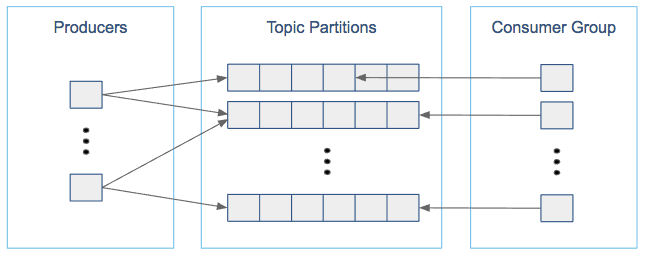Choosing the number of partitions for a topic
Learn how to determine the number of partitions each of your Kafka topics requires.
Choosing the proper number of partitions for a topic is the key to achieving a high degree of parallelism with respect to writes to and reads and to distribute load. Evenly distributed load over partitions is a key factor to have good throughput (avoid hot spots). Making a good decision requires estimation based on the desired throughput of producers and consumers per partition.

For example, if you want to be able to read 1 GB/sec, but your consumer is only able process 50 MB/sec, then you need at least 20 partitions and 20 consumers in the consumer group. Similarly, if you want to achieve the same for producers, and 1 producer can only write at 100 MB/sec, you need 10 partitions. In this case, if you have 20 partitions, you can maintain 1 GB/sec for producing and consuming messages. You should adjust the exact number of partitions to number of consumers or producers, so that each consumer and producer achieve their target throughput.
So a simple formula could be:
#Partitions = max(NP, NC)where:
NPis the number of required producers determined by calculating:TT/TPNCis the number of required consumers determined by calculating:TT/TCTTis the total expected throughput for our systemTPis the max throughput of a single producer to a single partitionTCis the max throughput of a single consumer from a single partition
This calculation gives you a rough indication of the number of partitions. It's a good place to start. Keep in mind the following considerations for improving the number of partitions after you have your system in place:
- The number of partitions can be specified at topic creation time or later.
- Increasing the number of partitions also affects the number of open file descriptors. So make sure you set file descriptor limit properly.
- Reassigning partitions can be very expensive, and therefore it's better to over- than under-provision.
- Changing the number of partitions that are based on keys is challenging and involves manual copying.
- Reducing the number of partitions is not currently supported. Instead, create a new a topic with a lower number of partitions and copy over existing data.
- Metadata about partitions are stored in ZooKeeper in the form of
znodes. Having a large number of partitions has effects on ZooKeeper and on client resources:- Unneeded partitions put extra pressure on ZooKeeper (more network requests), and might introduce delay in controller and/or partition leader election if a broker goes down.
- Producer and consumer clients need more memory, because they need to keep track of more partitions and also buffer data for all partitions.
- As guideline for optimal performance, you should not have more than 4000 partitions per broker and not more than 200,000 partitions in a cluster.
Make sure consumers don’t lag behind producers by monitoring consumer lag. To check consumers' position in a consumer group (that is, how far behind the end of the log they are), use the following command:
kafka-consumer-groups --bootstrap-server BROKER_ADDRESS --describe --group CONSUMER_GROUP --new-consumer